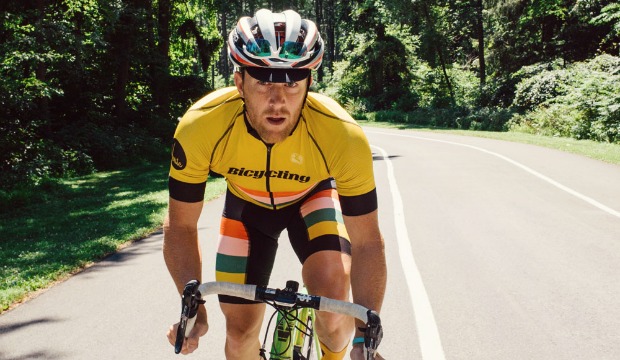
Flip through a rack of cycling jerseys at your local bike shop, and you’ll see options priced anywhere from $50 to $350. You’ve likely noticed the differences in quality, but what exactly goes into the price tag? We enlisted Mike Herlinger of Club Ride, Brad Sheehan of Velocio, and Giordana Andretta of Giordana to tell us the difference between a budget jersey and a spendier splurge.
$100 and Under
The biggest cost of making a cycling jersey is the fabric. Less expensive jerseys use simpler fabrics, so they may or may not absorb moisture or wick sweat. In high-end jerseys, fancy treatments like UPF (more on UPFhere) and odor control are permanent, but in a $100 jersey, those treatments are more likely to wash out.
A budget jersey might also look less flattering, and it’s not just because you've been packing in those extra post-ride beers—Sheehan says manufacturers have to balance the cost of sewing with the cost of fabric waste, so a brand may cut simpler patterns to get the most pieces from a single swath of fabric. “In sub-$100 jerseys, typically seams are straight because they’re quicker to sew, with less waste.” He says. The resulting fit will be "blockier" rather than tailored.
More: These Cycling Kits Are Designed to Stand Out
“If you’re paying $100 for a jersey,” says Herlinger, “that means the retailer paid $50, the manufacturer bought it for $25, and the factory produced it for around $12”—and you get what they pay for.
What budget kits do well is get you on your bike with minimum stress on your wallet. And some options are actually pretty decent; larger brands tend to be cheaper because they can order fabrics in bulk to keep overhead low, and some companies, like Giordana, also trickle down technology from high-end production. For example, Giordana’s $100 jersey has the same UPF nanotechnology as its $200 jersey—which means the sun protection won’t ever wash out.
The way Herlinger puts it, “that doesn’t mean you can’t find a great jersey for under $100. It just means that if you want the best money can buy, it’s going to cost you.”
$100 to $200
“As price climbs, your jersey becomes a BMW instead of a Volkswagen,” says Herlinger. Look for locking zippers; hems and sleeves that stay put without grippers; pockets that don’t sag when they’re loaded with stroopwafels; and consistency of fit. “You don’t get that R&D in a $50 jersey,” says Sheehan.
You'll also get some strategically placed premium fabrics. In this price range you'll see hi-tech kit features like mesh under the arms for breathability, or directional panels that only stretch in certain ways depending on how the jersey should move. These specialized fabrics perform better, but they tend to cost more than their budget counterparts.
The construction of a pricier jersey also gets better. “In a $150 jersey, seams have shape,” says Sheehan. You lay a $150 jersey on the table, and it won’t be flat because it’s sewn in 3D to mimic a human body.” Velocio strives for what it calls flexible fit—a jersey that fits close to the body, “but not so tight that you feel like a sausage.” Of course, the result is that these jerseys are sometimes so complicated that they require exceptionally skilled sewers; in the cases of Velocio and Giordana, some sewers at their Italian factories have been in the jersey business for generations.
And while we’re on the topic of Italy, consider that where your jersey is made can also affect the price. For example, any garment made in the European Union is subject to strict environmental and labor laws, so the number on the price tag will reflect the cost of environmental offsets, as well as good wages and working conditions.
$200 and Up
“Price is a really strange thing,” says Sheehan. “There is a psychological component that if it costs more it's better... But it’s often true.”
And aside from "kit doping" (a scientific phenomenon where looking good actually makes you faster), premium cycling apparel tends to pack a serious technological punch. When you get into this price range, you can expect the very best in fit and fabrics, as well as the leading edge of whatever the brand has to offer. Often you’ll be enjoying features developed for racers and teams—this price range is where designers really get to flex their muscles.
More: Have you Seen This Massive Collection of Rare Cycling Jerseys?
Giordana Andretta, sales manager at Giordana, says that when you buy a $200 jersey from Giordana, you’re paying for real innovation—which means proprietary fabrics, sometimes woven on machines the company and its partners designed and built.
For example, the FR-C jersey, (which we use for our custom kit, now just $120 in the Bicycling Shop) features fabric composed partially of carbon fiber, and a mechanical weave designed to push moisture away from your body. “It’s strong and light with odor control comparable to silver,” Andretta says. The carbon also dissipates electronic discharge from powerlines or cell phones, which is thought to promote qualities of wellbeing.
Whether the value is worth the price is up to you and your wallet, but for those days that require a special kit, a splurge might keep you looking and riding just a little bit better.
Read the original article on Bicycling.com.
 Ready to ride? Search for a cycling event.
Ready to ride? Search for a cycling event.

